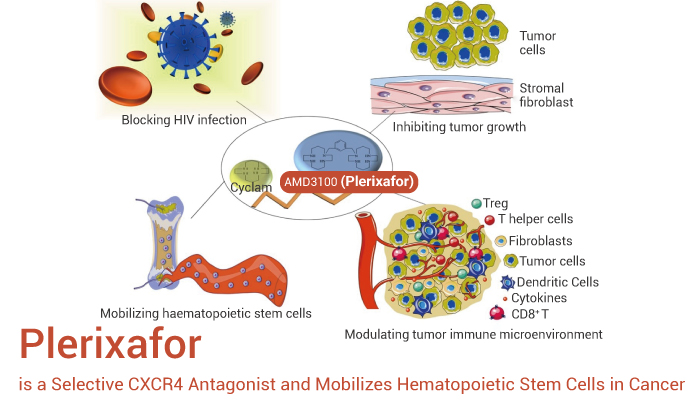CXCR4 is a chemokine receptor mainly located on the cell membrane of CD34+ cells and various inflammatory cells. SDF-1α/CXCL12 (chemokine stromal cell-derived factor 1 α) is a ligand of CXCR4. It determines hematopoietic stem cells (HSCs) homing to the bone marrow and quiescence. As reported, pro-angiogenic cell transplantation is a new treatment option for fibrotic diseases. Therefore, the SDF-1/CXCR4 system can mobilize pro-angiogenic cells from the bone marrow to other tissues, increasing local numbers. SDF-1 first binds to CXCR4 on precursor cells, leading to retention of hematopoietic stem cells in the bone marrow (BM). SDF-1 is degraded in the BM and CXCR4 expression is increased on precursor cells, leading to the recruitment of bone marrow precursor cells to damaged tissues. Finally, proangiogenic cells migrate from the bone marrow (BM). Here we introduce a potent CXCR4 antagonist, Plerixafor (IC50=44 nM). It inhibits the mobilization and migration of BM-derived pro-angiogenic cells.
Plerixafor (AMD3100) is a selective CXCR4 antagonist with immune stimulation and hematopoietic stem cell mobilization functions.
Plerixafor interferes with the interaction of CXCR4 with SDF-1 (CXCL12), thereby inhibiting CXCL12-mediated chemotaxis. Moreover, it can increase the release of hematopoietic stem cells (HSCs) and help them enter the blood circulation system. Plerixafor facilitates the collection of peripheral blood stem cells. CXCR4 has been reported to reduce organ fibrosis in the lung, liver, and myocardium. However, as Plerixafor processing time increases, there will be different effects. In a UUO-induced mouse renal fibrosis model, Plerixafor (2 mg/kg/days; ip; 5 days) promoted renal fibrosis by exacerbating T cell-associated renal inflammation. For example, it increases α-SMA, PDGFR-β, and type IV collagen expression, aggravating tubulointerstitial injury and fibrosis. Plerixafor also increases inflammatory cytokine secretion and promotes CD3-positive cell infiltration. Long-term continuous administration inhibits the homing of bone marrow-derived pro-angiogenic cells and worsens renal injury and fibrosis. In particular, it aggravates fibrosis in animals with myocardial infarction.
In summary, Plerixafor is a CXCR4 antagonist and CXCR12 secretion inhibitor that can increase the release of hematopoietic stem cells into the peripheral blood system. But the long-term effects of Plerixafor can exacerbate kidney damage and fibrosis.
References:
[1] Müller TA, et al. Leukemia. 2019 May;33(5):1296-1301.
[2] Yang J, et al. PLoS One. 2016 Feb 22;11(2):e0149926.
